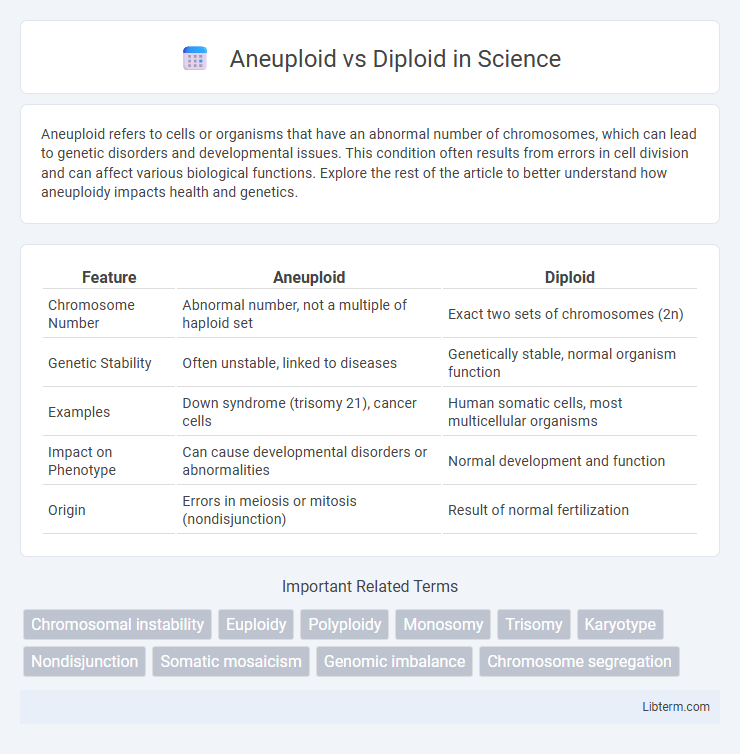Aneuploid refers to cells or organisms that have an abnormal number of chromosomes, which can lead to genetic disorders and developmental issues. This condition often results from errors in cell division and can affect various biological functions. Explore the rest of the article to better understand how aneuploidy impacts health and genetics.
Table of Comparison
| Feature | Aneuploid | Diploid |
|---|---|---|
| Chromosome Number | Abnormal number, not a multiple of haploid set | Exact two sets of chromosomes (2n) |
| Genetic Stability | Often unstable, linked to diseases | Genetically stable, normal organism function |
| Examples | Down syndrome (trisomy 21), cancer cells | Human somatic cells, most multicellular organisms |
| Impact on Phenotype | Can cause developmental disorders or abnormalities | Normal development and function |
| Origin | Errors in meiosis or mitosis (nondisjunction) | Result of normal fertilization |
Introduction to Ploidy: Understanding Chromosome Sets
Aneuploid cells possess an abnormal number of chromosomes, deviating from the typical diploid set found in most organisms, which consists of two complete sets of chromosomes--one from each parent. Diploid cells contain homologous pairs of chromosomes, ensuring genetic stability and normal cellular function, while aneuploidy can lead to genetic disorders or diseases such as cancer. Understanding ploidy provides essential insights into chromosome behavior during cell division and helps in studying the genetic basis of development and pathology.
What is Diploidy? The Standard Chromosomal State
Diploidy refers to the standard chromosomal state in most eukaryotic organisms where cells contain two complete sets of chromosomes, one inherited from each parent, typically represented as 2n. This chromosomal arrangement ensures genetic stability and proper function during cell division, particularly in somatic cells. In contrast, aneuploidy involves an abnormal number of chromosomes, leading to genetic imbalances and associated disorders.
Defining Aneuploidy: When Chromosome Numbers Vary
Aneuploidy occurs when the number of chromosomes deviates from the typical diploid set, resulting in cells with missing or extra chromosomes. Unlike diploid cells, which contain two complete sets of chromosomes (one from each parent), aneuploid cells exhibit an abnormal chromosome count, often leading to genetic imbalances and disorders. This variation in chromosome number significantly impacts cellular function and organismal development.
Causes of Aneuploidy: Mechanisms and Triggers
Aneuploidy arises from errors in chromosome segregation during cell division, primarily caused by nondisjunction events in meiosis or mitosis. These mechanisms include spindle assembly checkpoint failures, cohesion defects, and kinetochore malfunctions, which disrupt proper chromosomal alignment and attachment. Environmental factors such as chemical exposure, radiation, and advanced maternal age also trigger increased rates of aneuploidy by impairing cellular machinery involved in chromosome segregation.
Comparison Chart: Aneuploid vs Diploid Cells
Aneuploid cells contain an abnormal number of chromosomes, either missing or extra chromosomes, while diploid cells have two complete sets of chromosomes, one from each parent, totaling 46 in humans. Aneuploidy often leads to genetic disorders or cancer due to chromosomal imbalances, whereas diploid cells maintain genomic stability essential for normal growth and development. Key distinctions include chromosome number accuracy, phenotypic outcomes, and cellular function, making diploid cells crucial for organismal health compared to the typically harmful effects of aneuploidy.
Genetic Consequences of Aneuploidy vs Diploidy
Aneuploidy results in cells with an abnormal number of chromosomes, leading to genetic imbalances that disrupt normal gene dosage and cause developmental abnormalities or diseases like Down syndrome. In contrast, diploidy maintains a balanced set of homologous chromosome pairs, ensuring proper gene expression and genomic stability essential for normal growth and reproduction. The genetic consequences of aneuploidy often include impaired cellular function and increased susceptibility to cancer, whereas diploidy supports genetic integrity and evolutionary adaptability.
Impact on Organism Health and Disease
Aneuploidy, the presence of an abnormal number of chromosomes, often disrupts gene dosage and cellular function, leading to developmental disorders and increased risk of cancers such as Down syndrome and various solid tumors. Diploid organisms maintain two complete sets of chromosomes, ensuring genetic stability and proper cellular operation, which supports normal growth and physiological processes. The imbalance caused by aneuploidy typically results in impaired cellular metabolism, genomic instability, and predisposition to diseases, highlighting the critical role of chromosomal integrity in organismal health.
Aneuploidy and Cancer: The Cellular Link
Aneuploidy, characterized by an abnormal number of chromosomes, disrupts cellular function and genomic stability, playing a significant role in cancer development. Unlike normal diploid cells with two complete sets of chromosomes, aneuploid cancer cells exhibit chromosomal imbalances that contribute to uncontrolled cell division and tumor progression. This chromosomal instability is a hallmark of many malignancies, linking aneuploidy directly to oncogenesis and cancer aggressiveness.
Diagnostic Techniques for Detecting Chromosomal Variations
Fluorescence in situ hybridization (FISH) and comparative genomic hybridization (CGH) are primary diagnostic techniques for detecting aneuploidy and diploidy variations in chromosomes. Karyotyping remains a gold standard for visualizing structural and numerical chromosomal abnormalities, while next-generation sequencing (NGS) offers high-resolution detection of subtle chromosomal copy number variations. Quantitative PCR (qPCR) is also employed for rapidly identifying specific aneuploidies, enhancing prenatal and cancer diagnostics.
Conclusion: Significance of Ploidy in Genetics and Medicine
Aneuploidy, characterized by an abnormal number of chromosomes, contrasts with diploidy, where organisms maintain two complete sets of chromosomes, crucial for genetic stability. The significance of ploidy lies in its impact on developmental biology, disease manifestation, and therapeutic strategies, with aneuploid conditions often linked to genetic disorders and cancers. Understanding ploidy dynamics enables advancements in personalized medicine, prenatal diagnostics, and targeted gene therapies, highlighting its critical role in genetics and medicine.
Aneuploid Infographic

 libterm.com
libterm.com